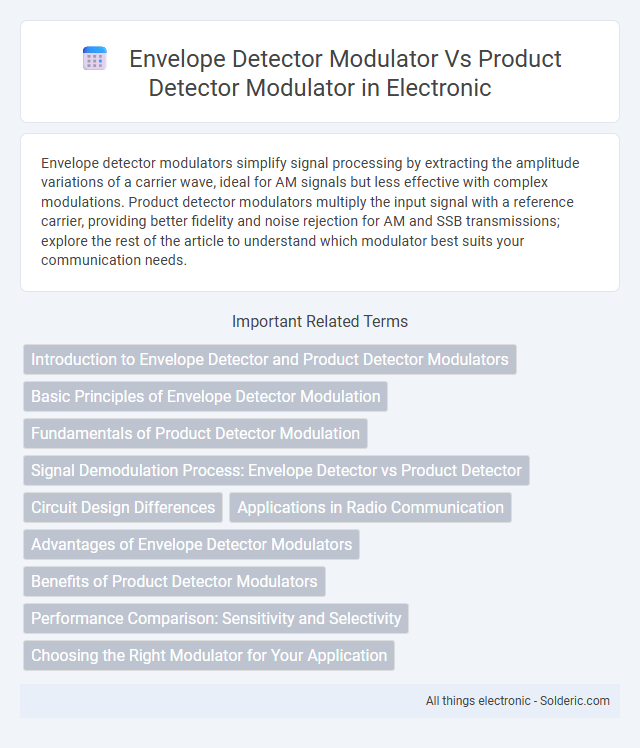Envelope detector modulators simplify signal processing by extracting the amplitude variations of a carrier wave, ideal for AM signals but less effective with complex modulations. Product detector modulators multiply the input signal with a reference carrier, providing better fidelity and noise rejection for AM and SSB transmissions; explore the rest of the article to understand which modulator best suits your communication needs.
Comparison Table
| Feature | Envelope Detector Modulator | Product Detector Modulator |
|---|---|---|
| Working Principle | Detects envelope of the modulated signal | Multiplies carrier with input signal (mixing) |
| Complexity | Simple, low-cost design | More complex, requires balanced mixer |
| Signal Types | AM signals with large carrier | AM, SSB, and suppressed carrier signals |
| Performance in Noise | Poor noise immunity | Better noise rejection and fidelity |
| Output Quality | Distortion in low carrier levels | High fidelity, low distortion |
| Usage | Simple AM demodulation | Complex signals including SSB, coherent detection |
Introduction to Envelope Detector and Product Detector Modulators
Envelope detector modulators extract the original signal by tracking amplitude variations of the carrier wave, making them suitable for simple amplitude modulation (AM) systems. Product detector modulators multiply the received modulated signal with a locally generated carrier, allowing precise demodulation of signals with suppressed or complex carriers, such as single-sideband (SSB) transmissions. Your choice between these modulators depends on the required signal quality and complexity of the modulation scheme.
Basic Principles of Envelope Detector Modulation
Envelope detector modulation operates by extracting the amplitude variations of a modulated carrier signal, relying on a simple diode and low-pass filter to demodulate the message. This technique translates the envelope of the amplitude-modulated waveform directly into the original information signal, making it suitable for AM transmissions with a consistent carrier presence. Your choice between envelope and product detector modulators depends on factors like signal complexity and noise resilience, as envelope detectors excel in simplicity but are less effective with suppressed carriers or complex modulation schemes.
Fundamentals of Product Detector Modulation
Product detector modulation relies on multiplying the incoming modulated signal with a locally generated carrier to extract both amplitude and phase information, enabling precise demodulation of amplitude and single sideband signals. It utilizes synchronous detection, preserving the carrier's phase coherence, which significantly improves signal-to-noise ratio and fidelity compared to envelope detectors. This method is essential in communication systems requiring accurate demodulation of complex modulated waveforms, particularly in suppressed-carrier transmissions.
Signal Demodulation Process: Envelope Detector vs Product Detector
The envelope detector modulator demodulates signals by extracting the amplitude envelope of the incoming amplitude-modulated (AM) wave, using a diode followed by a low-pass filter to recover the original baseband signal. In contrast, the product detector modulator demodulates by multiplying the received signal with a locally generated carrier signal, enabling coherent detection that preserves phase information and improves sensitivity, particularly in the presence of noise. Envelope detectors are simpler and effective for AM signals with a strong carrier, while product detectors excel in demodulating suppressed-carrier signals and offer better performance for complex modulation schemes like single-sideband (SSB).
Circuit Design Differences
Envelope detector modulator circuits utilize a simple diode and RC network to demodulate AM signals by extracting the envelope from the carrier, which makes them efficient for signals with strong carriers and minimal distortion. Product detector modulators employ a mixer and a local oscillator, enabling coherent detection that accurately recovers the original signal even under weak signal conditions or in the presence of noise. Your choice between these modulators significantly impacts circuit complexity and performance, with product detectors generally requiring more intricate design but offering superior signal fidelity.
Applications in Radio Communication
Envelope detector modulators excel in AM radio broadcasting due to their simplicity and cost-effectiveness, making them ideal for transmitting amplitude-modulated signals. Product detector modulators, however, are preferred in SSB (Single Sideband) and digital radio systems where higher sensitivity and selectivity are critical for demodulating weak or complex signals. Your choice depends on the application's requirements for signal clarity, bandwidth efficiency, and noise performance in radio communication.
Advantages of Envelope Detector Modulators
Envelope detector modulators offer simplicity in design and ease of implementation, making them highly cost-effective for amplitude modulation applications. They efficiently demodulate signals with constant carrier amplitude, resulting in low power consumption and minimal hardware requirements. This makes envelope detector modulators well-suited for low-complexity communication systems where bandwidth efficiency and signal fidelity are moderately prioritized.
Benefits of Product Detector Modulators
Product detector modulators offer superior performance in demodulating amplitude modulated signals by effectively recovering both amplitude and phase information, resulting in higher fidelity audio output compared to envelope detector modulators. They excel in minimizing distortion and noise, especially in weak or noisy signal conditions, enhancing the clarity and accuracy of your received signal. This makes product detector modulators ideal for applications requiring precise signal demodulation and improved overall communication quality.
Performance Comparison: Sensitivity and Selectivity
Envelope detector modulators offer moderate sensitivity but lower selectivity, making them suitable for simple amplitude modulation (AM) signals with minimal interference. Product detector modulators provide superior sensitivity and enhanced selectivity by demodulating signals through multiplication of the incoming carrier and local oscillator, effectively recovering weak signals and rejecting noise. Your choice depends on whether improved weak signal detection and interference rejection (product detector) outweigh the simplicity and lower cost of envelope detectors.
Choosing the Right Modulator for Your Application
Envelope detector modulators are ideal for simple AM signals with low complexity and cost considerations, offering efficient demodulation but limited performance in noisy environments. Product detector modulators provide enhanced sensitivity and selectivity, making them suitable for complex or low-level signals in high-performance communication systems. Selecting the right modulator depends on noise conditions, signal complexity, and system requirements for fidelity and cost efficiency.
Envelope detector modulator vs product detector modulator Infographic

 solderic.com
solderic.com